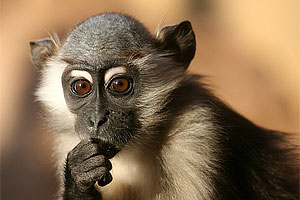 Hmmm... I think I 'm a monkey... but how do I know for sure? Image credit: Erwin Bolwidt / law_keven / CC BY-SA 2.0
Hmmm... I think I 'm a monkey... but how do I know for sure? Image credit: Erwin Bolwidt / law_keven / CC BY-SA 2.0
Monkeys have tails. Monkeys have tails. Monkeys have tails. If you leave the zoo learning one thing about primates, learn that monkeys have tails and apes do not. This is one zoo science standard that we try to teach all visiting school children, even the kindergarteners. They are quick to learn, and teach others. They do not hesitate to correct a parent who is pointing to our tail-free chimpanzees saying, "Look at the monkey". Makes me proud.
In preparation for our upcoming Conservation Speaker Series presenter, Noel Rowe, Founder of Primate Conservation, Inc, I decided to delve further into understanding primates by picking up his book, The Pictorial Guide to the Living Primates.
After being in the zoo industry for eight years, I figured I knew quite a bit, but I opened up the book with some of my most experienced and knowledgeable co-workers and we were all awe-struck.
Let's begin by getting clear that a primate is a monkey, ape or prosimian. A monkey has a tail, an ape does not and a prosimian is like a lemur or bush baby. The word "prosimian" means "before apes" and is still not recognized by spell check who insists I must mean "promising." Let's hope that is the case for all primates. My hope for this blog is to expose my top 4 new favorite primates.
